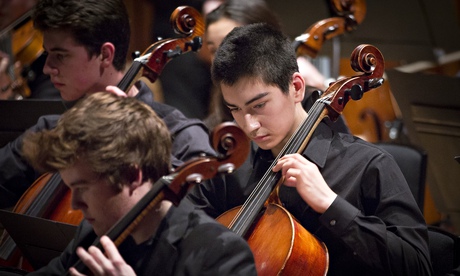
In his sequel to The Hitchhiker’s Guide to the Galaxy, Douglas Adams invented a plutonium rock band so loud it could destroy planets. Audiences were advised to listen from a concrete bunker and the musicians played by remote control. The Barbican is not a concrete bunker – well, OK, up to a point. Nor is the National Youth Orchestra of Great Britain a fictional ensemble or their instrumental control anything but close and precise.
When all 163 of these gifted 13- to 19- year-old musicians from all over the country play fortissimo, the eruption is aurally volcanic. In the concert hall it is hard to imagine louder. (Guinness World Records abandoned its “loudest band” category a while ago for fear of encouraging ear damage so we will never know.) Volume is hardly synonymous with musicality – to understate it – but in the hands of these brilliant young players, how thrilling to be knocked sideways by their demonstrable passion and technical assurance.
They played Bach (arr Elgar), Respighi’s gaudy orchestral showpiece The Pines of Rome and then Elgar proper, his Symphony No 1, under the vivacious baton of John Wilson. Contrary to assumption, despite the vast number who squeeze on to the platform, they do not all play relentlessly and loudly throughout. Solos are just that: one plucky soul braving it alone. The oboist (Hannah Condliffe, 17) in the Bach, the timpanist (Elliott Gaston-Ross, 15) in the Respighi, and the clarinettist (John Tothill, 18) stood out in a crowd bustling with talent.
Wilson drove the Elgar symphony slowly and majestically, as if steering a prototype Rolls-Royce from the time the work was written (1907-8). This was a good solution to handling so many strings without muddying textures, even if the opening did feel a little too stately. Violas, cellos and basses caught the “nobilmente” mood well, and the many brass-rich outbursts were visceral and exciting – as well they might be with nine trumpets, eight trombones and three tubas. Elgar would surely have loved it. So too would the critic and Elgar scholar Michael Kennedy, who made us rethink this often misunderstood composer. Kennedy, who died on New Year’s Eve, aged 88, also spent much of his long life supporting new talent.
This January concert, one of three each year, is the first chance to hear the new NYO intake. In a week in which a flurry arose over some statistics suggesting, surprise, surprise, male dominance in the classical music world, the NYO bucks the trend: 52% of the new line-up is female, including the leader (Stephanie Childress, 15). Section principals are equally divided between boys and girls. The orchestra was founded by a woman, Ruth Railton. Its patron, chair, chief executive, finance director and rehearsal conductor are women. The world premiere commission for the orchestra’s 2015 Easter concert is by Unsuk Chin, and three of the NYO’s own six young composer members are female.
What does this show? Perhaps only that it’s easier to measure a mainstream tendency (Beethoven, Brahms, Bach? All men. Bah) than to calibrate change, with all its slowness and hesitancy and, in the case of our collapsing music education, obstacles. The graph is going up for women. You only have to get out there and look.
The NYO has also worked hard to rid itself of some of its own whiskery tendencies. The “south-east-public-school-middle-class” tag is fast receding. I have watched closely how the organisation has reinvented itself, consistently and vigorously, over the past decade. This year’s players, half of them from state schools, come from as far afield as Bradford, Carrickfergus, Truro and Machynlleth. Of those from independent schools, 95% receive financial assistance towards fees. 18% of the orchestra’s members are from black and minority ethnic backgrounds, which is 3% above the national average.
Their progress, with musical standards always to the fore, needs shouting, if only to quieten those still preoccupied with past habits instead of hopes. A small number from the orchestra will enter the profession. For the majority, as with music making at even the lowliest level, it sets them up for life in ways they may take years to realise. The more who have that chance the better.
That other stalwart champion of young artists, the Park Lane Group, opened its annual week of concerts at the Purcell Room (moving to St John’s, Smith Square next year while the Purcell Room is being renovated). Monday’s opening focused on the music of Robert Saxton, with additions from Thomas Adès, Robin Holloway, Thomas Hyde and György Kurtág. You could have constructed a fascinating Venn diagram, or better an infographic, from the spirited audience in attendance, all of whom seemed to be interconnected. Both Holloway and Saxton have taught a generation of British composers, many of whom had turned out in warm support.
The pianist Gamal Khamis, who gave his Wigmore Hall recital at the age of 10, diverted for a few years to take a maths degree at Imperial College and is now a PLG young artist, was dazzling in Holloway’s jubilant romantic miniature, Ballade, Op 90 No 1 (2000). He also played part of Adès’s Concert Paraphrase on Powder Her Face and Saxton’s glistening, subtle Hortus Musicae (2013), inspired by the notion of a metaphysical garden. The Maxwell Quartet, formed at the Royal Conservatoire of Scotland and dedicated to expanding the repertoire, played Saxton’s String Quartet No 3 (2011), capturing the contrasting character of each of the five movements with titles such as Winter Light and Dance. Ideas reveal and hide themselves in constant, delicate oscillation. In one (Sea Ground), he uses a passacaglia, mirroring the repeated yet changing action of the sea. This music, in this performance, had a mystery, delicacy and depth which made you want to hear it again immediately. What an exhilarating start to 2015.
Star ratings (out of 5)
National Youth Orchestra of Great Britain ****
Park Lane Group ****

